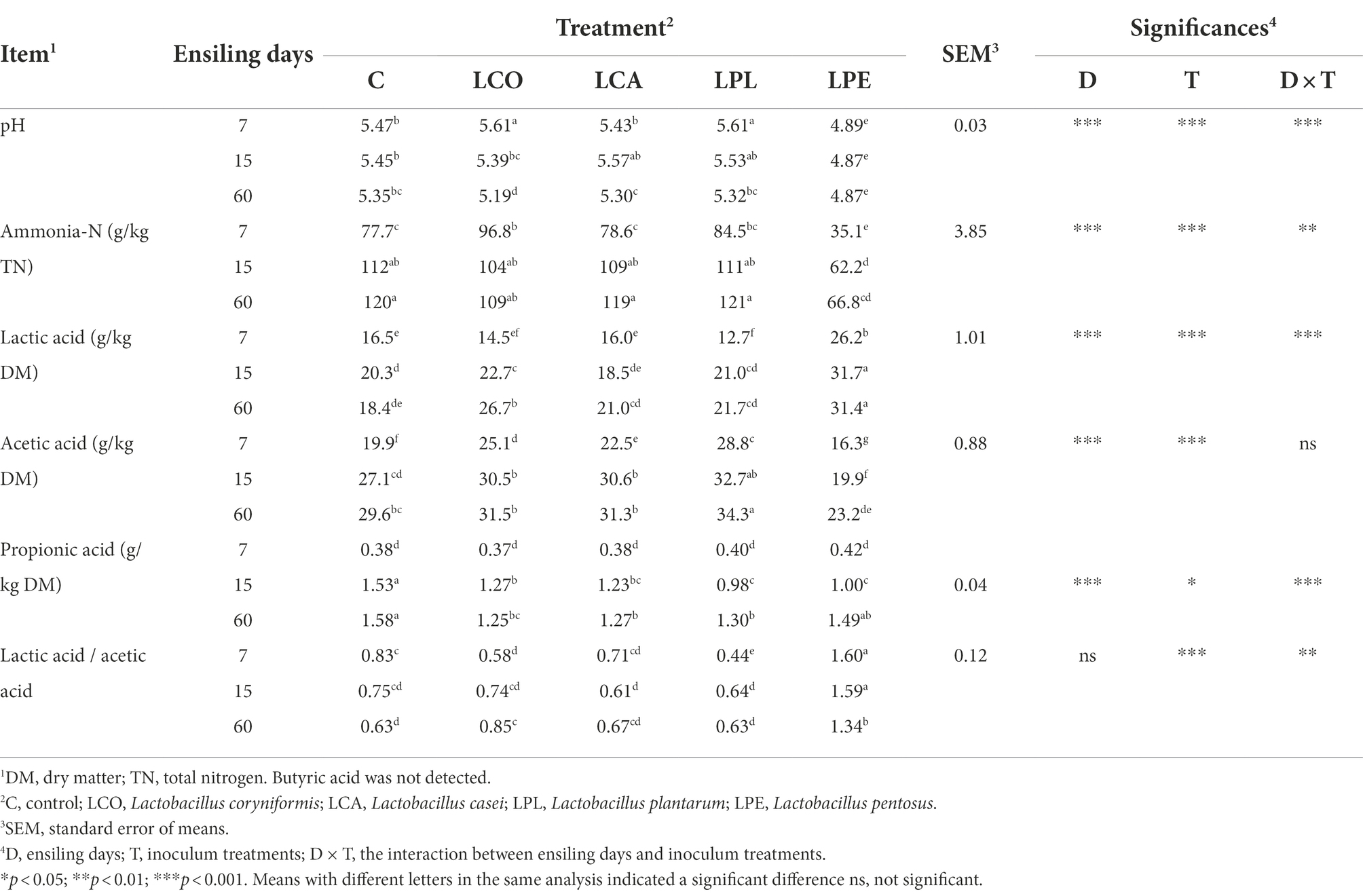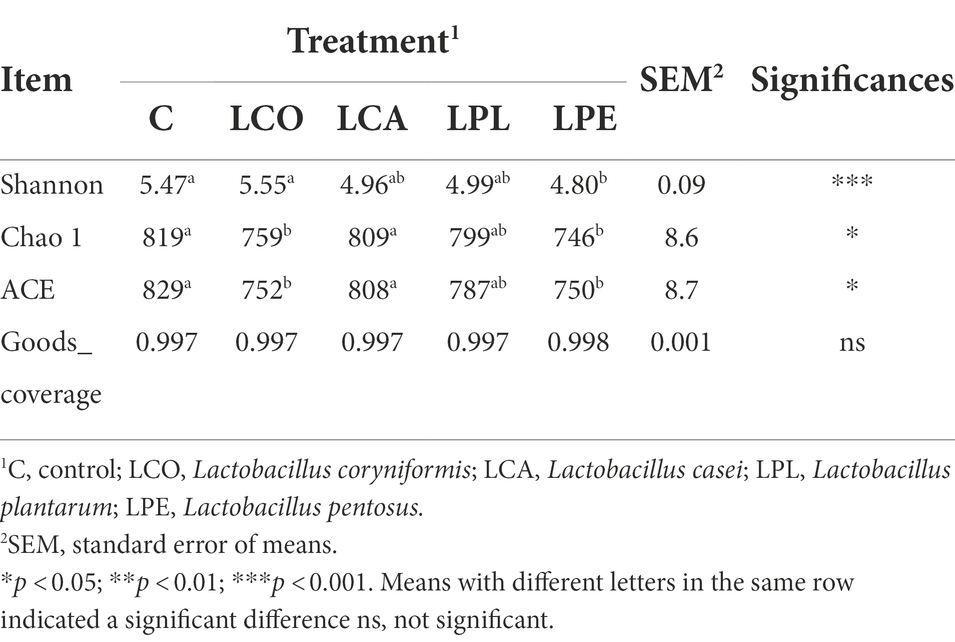- Animal Sciences College, Shanxi Agricultural University, Taigu, Shanxi, China
Introduction: Alfalfa (Medicago sativa L.) silage is one of the major forages with high protein for ruminants.
Methods: The objective of this study was to investigate the effects of lactobacilli inoculants on protein and carbohydrate fractions, ensiling characteristics and bacterial community of alfalfa silage. Wilted alfalfa (35% dry matter) was inoculated without (control) or with Lactobacillus coryniformis, Lactobacillus casei, Lactobacillus plantarum, and Lactobacillus pentosus and ensiled for 7, 15, and 60 days.
Results and discussion: Silage inoculated with L. pentosus was superior to L. coryniformis, L. casei, L. plantarum in improving the fermentation quality of alfalfa silage, as indicated by the lowest ammonia nitrogen content and silage pH during ensiling. There was minor difference in water soluble carbohydrates content among all silages, but L. pentosus inoculants was more efficient at using xylose to produce lactic acid, with lower xylose content and higher lactic acid content than the other inoculants. Compared with the control, L. pentosus inoculants did not affect true protein content of silage, but increased the proportions of buffer soluble protein and acid detergent soluble protein. The L. pentosus inoculants reduced the bacterial diversity In alfalfa silage with lower Shannon, Chao1, and Ace indices, and promoted relative abundance of lactobacillus and decreased the relative abundance of Pediococcus compared with the control. As well as L. pentosus inoculants up-regulated amino acid, carbohydrate, energy, terpenoids, and polypeptides metabolism, and promoted lactic acid fermentation process. In summary, the fermentation quality and nutrient preservation of alfalfa silage were efficiently improved by inoculated with L. pentosus.
Introduction
With the rapid development of ruminant husbandry, alfalfa (Medicago sativa L.) becomes an essential roughage for dairy ration. Ensiling is one of the effective methods to preserve alfalfa nutrients (Ertekin and Kizilsimsek, 2020). During ensiling, most true protein (TP) fractions in alfalfa are degraded into non-protein nitrogen (NPN). In particular, the activity of harmful microorganisms, such as clostridia and enterobacteria, extensively reduce the amino acids content, leading to nutrient losses (Buxton et al., 2003). In the past few decades, numerous researchers have reduced proteolysis of alfalfa silage by inoculating with lactobacilli, which can rapidly reduce silage pH and future prevent activities of plant proteolytic enzymes and harmful microorganisms, and effectively reduce NPN, especially ammonia formation (Oliveira et al., 2017; Tian et al., 2017; Kung et al., 2018). Homofermentative lactobacilli rapidly reduce alfalfa silage pH is more effective than heterofermentative lactobacilli (Contreras-Govea et al., 2011), and Lactobacillus plantarum is commonly used. In fact, L. plantarum is a facultative heterofermentative lactic acid bacteria (LAB), which produce acetic acid and reduce the acidification efficiency of silage under the insufficient hexose, and alfalfa is usually low in hexose (Buxton et al., 2003). However, little attention has been paid to comparing the effects of different homofermentative lactobacilli species on nitrogen distribution of alfalfa silage.
The efficacy of LAB inoculants is influenced not only by its phenotypic characteristics, but also by chemical and microorganism characteristics of pre-ensiling material (Tohno et al., 2012). Similarly, changes in chemical composition of silage are also inextricably linked to changes in microbial communities during ensiling. Therefore, it is essential for thoroughly understand and improve the fermentation quality of silage to monitor the relationship between changes in chemical composition and microbial communities during ensiling process (Namihira et al., 2010; Wang et al., 2020). In addition, it is difficult to evaluate the nitrogen distribution of alfalfa silage based on the traditional feed nutrition assessment system, while the Cornell’s net carbohydrate and protein system could reflect the nutritional components of feed more comprehensively and objectively (Wang et al., 2009).
Thus, the purpose of current study was to investigate the effects of homofermentative lactobacilli (Lactobacillus coryniformis, Lactobacillus casei, and Lactobacillus pentosus) and facultative heterofermentative lactobacilli (L. plantarum) on the fermentation quality and nutrient preservation of alfalfa silage, based on ensiling characteristics, protein fractions, carbohydrate fractions and bacterial diversity and functional analysis.
Materials and methods
Silage preparation
Alfalfa (Medicago sativa L., cultivar SR 4030) planted for 2 years was harvested at budding stage on May 15, 2021, and wilted to about 35% dry matter (DM) in the experimental field (37°25′08″N, 112°35′25″E, elevation 783 m) of Shanxi Agricultural University (Taigu, China). The wilted alfalfa was chopped into approximately 20 mm and divided into 60 sub-samples (2.5 kg per sub-sample), which were assigned to the following ensiling treatments in four replicates: (1) Control (sprayed with equal distilled water, C); (2) L. coryniformis (LCO); (3) L. casei (LCA); (4) L. plantarum (LPL) and (5) L. pentosus (LPE). Each treatment was sprayed onto the forage with a mini-sprayer at a rate of 1.0 × 106 cfu/g fresh weight (FW). After thoroughly mixing, 500 g of the treated forage was packed into a laboratory sterile plastic bag with a release valve, vacuum-sealed and stored at room temperature for 7, 15, and 60 days.
Chemical composition and microbial amount analyses
Each silage sample was weighed (20 g) and diluted with twice the volume of distilled water for 24 h at 4°C, and then filtered through two layers of cheesecloth and a Whatman filter paper (Desta et al., 2016). The filtrate was used for determining pH, ammonia nitrogen (ammonia-N), lactic acid and volatile fatty acid (VFA, acetic, propionic and butyric acids) concentrations. Silage pH was measured by pH meter (pH FE28, Mettler-Toledo Instruments Co., Ltd., China). Ammonia-N and lactic acid were determined according to the method of Kleinschmit et al. (2005), and VFA concentrations were determined by gas chromatography with 30 m × 0.25 mm (df 0.25 μm) capillary column (Thermo T1300, United States; Guo et al., 2019).
DM content of raw material and silage were determined at 65°C for 48 h in an oven with forced-air circulation. Total nitrogen (TN) and ash contents were determined according to AOAC (2012). Organic matter (OM) content was estimated as DM minus ash, and CP content was calculated by multiplying TN by 6.25. Neutral detergent fiber (NDF), Acid detergent fiber (ADF), acid detergent lignin (ADL), neutral detergent insoluble protein (NDIP) and acid detergent insoluble protein (ADIP) contents were determined with the method of VanSoest et al., 1991. Water soluble carbohydrates (WSC) content was determined with the method of Kim and Adesogan (2006). Starch content was determined with an enzymatic method (Owens et al., 2002). Xylose content was determined with the method of Eberts et al. (1979). The TP and NPN contents were determined with the method of Licitra et al. (1996). The Cornell net carbohydrate and protein system was used to estimate the protein fractions of raw material and silage (Nadeau et al., 2012). Buffering capacity of raw material was analyzed by the method of Playne and McDonald (1966). Water activity was determined by water activity analyzer (HD-3A, Ester Instrument Co., Ltd., Xiamen, China).
Each sample (10 g) was mixed with 90 ml of sterilized saline solution (0.85% NaCl), and serially diluted with 10−1 and 10−8. The dilutions were used to analyze microbial counts with the pour plate method. The LAB were counted using the de Man, Rogosa and Sharpe agar plates (Basebio, Co., Ltd., Hangzhou, China) in an anaerobic box (TE-HER Hard Anaerobox, Hirosawa Ltd., Tokyo, Japan) at 35°C for 48 h. Total aerobic bacteria were counted on nutrient agar plates (Basebio, Hangzhou, China), and yeasts and molds were counted on rose bengal agar plates (Basebio, Hangzhou, China). The agar plates were maintained in an incubator at 30°C for 48 h (Cai et al., 1999).
Microbial community analysis
Each silage sample (20 g) was mixed with 180 ml of sterilized saline solution. Extracts were shaken at 4°C for 2 h (150 rpm/min), and filtered through two layers of cheesecloth. Then, pellets were obtained by centrifugation at 12000 rpm/min for 15 min at 4°C. Total DNA was extracted using TIANamp Bacteria DNA Kit (DP302-02, Tiangen, Beijing, China). The PCR was used to amplify the V3-V4 region of the bacterial 16S rRNA gene, with the forward primer 341F (CCTACGGGNGGC WGCAG) and the reverse primer 806R (GGACTACHVGGGTATCTAAT). PCR was performed using a PCR thermal cycler system (Mastercycler pro, Eppendorf, Germany). The reaction mixture (20 μL) contained 4 μL of 5 × FastPfu Buffer, 2 μL of 2.5 mM/l dNTPs, 0.4 μL of FastPfu-DNA-Polymerase, 0.8 μL of each primer and 20 ng of DNA template.
The PCR products were purified and quantified, and then sequenced at the Guangzhou Gene Denovo Company using Illumina platform (Hiseq2500 PE250). In order to quality-control, low quality sequences and chimera sequences were removed using QIIME software (version 1.9.1) and UCHIME algorithm, respectively. Then, the effective tags were clustered into Operational taxonomic units (OTUs) based on 97% similarity level by using UPARSE (version 7.0.1). Taxonomy classification of representative sequences at the phylum and genus were performed using Naïve Bayesian assignment algorithm of RDP (Version 2.2) by comparing with Silva database. Alpha diversity, including the Shannon index, Chao1 index, ACE index and Good’s coverage, and beta diversity, including the principal coordinate analysis (PCoA) was calculated using unweighted UniFrac distances. Functional prediction of microbial community was conducted using PICRUSt2. Sequence data were deposited in NCBI’s Sequence Read Archive under BioProject accession number PRJNA888371.
Statistical analysis
The data of microbial count were log10-transformed. Data on the fermentation parameters of silages were analyzed by two-way ANOVA with inoculants (C, LCO, LCA, LPL, and LPE), ensiling days (7, 15, and 60 days) and their interaction as the main effects. Data on the DM and OM contents, and carbohydrate and protein fractions of 60-days fermented silages were analyzed by one-way ANOVA with inoculants as the main effect. Multiple comparisons between the means were determined by Duncan’s test. All analyses were conducted using the SAS statistical program with the level of significance set at 5%.
Result and discussion
Characteristics of wilted alfalfa before ensiling
The DM level, WSC content, buffering capacity and epiphytic LAB population of forage are the main factors affecting the fermentation characteristics of silage (Buxton et al., 2003). In the range of 20 to 60% DM, alfalfa silage at about 35% DM had the lowest silage pH (Kung et al., 2018). As shown in Table 1, the DM content of wilted alfalfa was 343 g/kg FW, which was a suitable level. Besides, alfalfa normally needs additional WSC for high-quality silage production compared with other forages because of its high buffering capacity (Buxton et al., 2003). In the current study, the buffering capacity and WSC content in wilted alfalfa was 322 mEq/kg DM and 49.6 g/kg DM, respectively (Table 1). The WSC content did not meet the minimum requirements for sufficient fermentation according to Pitt (1990), who reported that the minimum initial WSC content is 140 g/kg DM for wilted alfalfa at 35% DM. The starch content in wilted alfalfa was 15.4 g/kg DM, which could be used as potential fermentation substrate for lactic acid bacteria (McDonald et al., 1991; Wang et al., 2020). The nitrogen in fresh alfalfa is typically 5 to 25% NPN, but it will increase 20 to 50% after wilting (Buxton et al., 2003). In the current study, the nitrogen in wilted alfalfa contained 31.2% NPN and 68.8% TP, and more than half of the TP were intermediately degradable protein (Table 1).
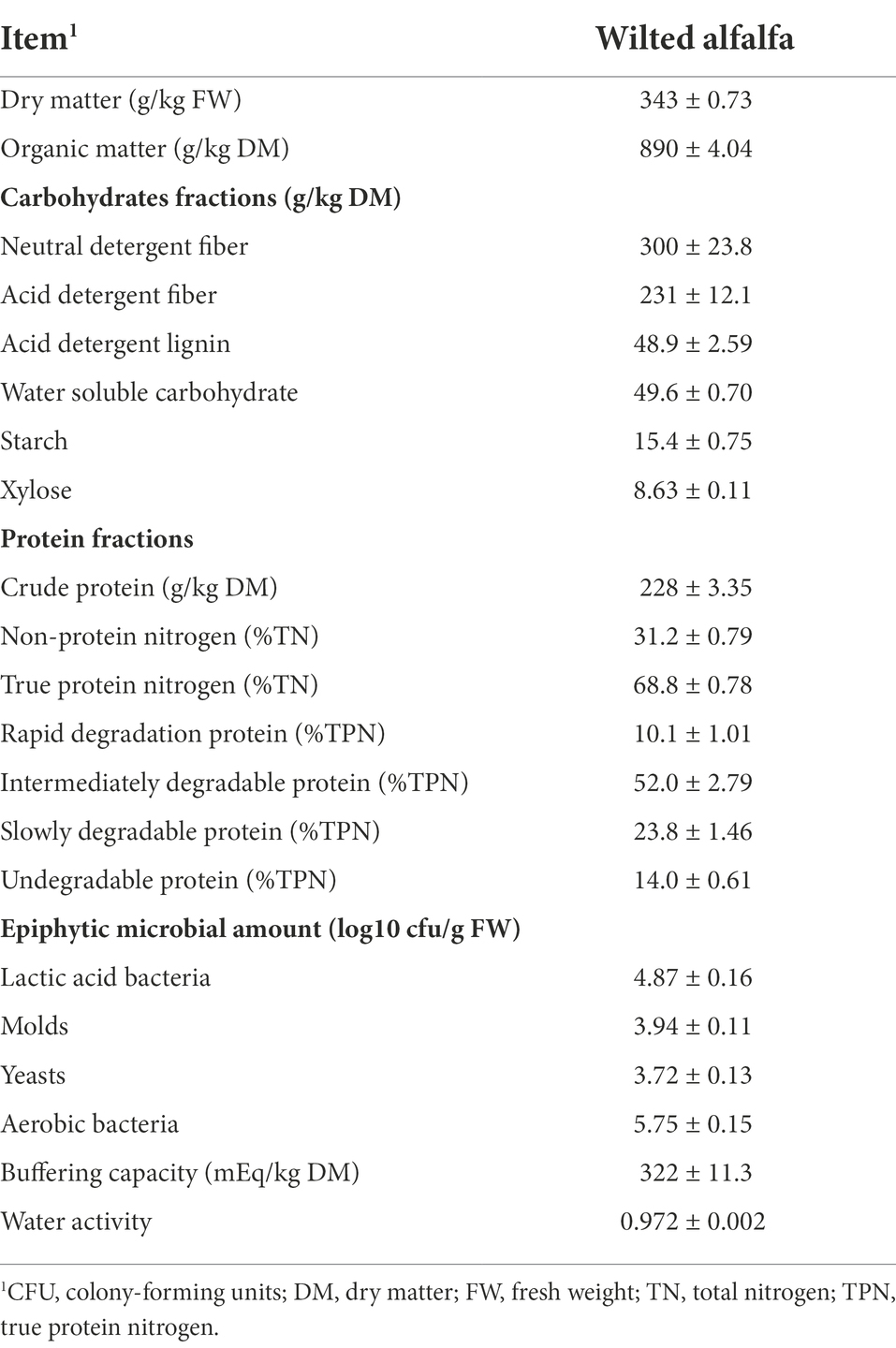
Table 1. Chemical composition, epiphytic microbial population, and buffering capacity of wilted alfalfa before ensiling.
The populations of epiphytic total aerobic bacteria, LAB, yeast and molds in wilted alfalfa were 5.75, 4.87, 3.72 and 3.94 log10 cfu/g FW, respectively (Table 1). The epiphytic LAB population was lower than 5 log10 cfu/g FW, which is the minimum amount to obtain well-preserved silage (Cai et al., 1999). The large number of aerobic bacteria in alfalfa, and the low population of epiphytic LAB do not ensure maximum fermentation during ensiling, this problem could be addressed by LAB inoculation.
Dynamics of fermentation characteristics of alfalfa silage inoculated with lactobacillus
The dynamics of pH, ammonia-N, lactic acid, acetic acid and propionic acid contents and the ratio of lactic acid to acetic acid in alfalfa silages are shown in Table 2. The contents of ammonia-N, lactic acid and propionic acid, as well as pH value were significantly (p < 0.05) affected by ensiling days, inoculation treatments and their interaction. The ensiling days and inoculation treatments significantly (p < 0.05) affected acetic acid content. In the initial stage of ensiling, rapid lactic acid fermentation inhibiting harmful microbiological and plant enzymatic activity is critical for silage preservation (Shao et al., 2005; Desta et al., 2016). Numerous studies reported that the inoculation of homofermentative lactobacillus could improve the quality of silage fermentation by rapid accumulation of lactic acid (Cai et al., 1999; Slavica et al., 2015; Ni et al., 2017; Li et al., 2018). However, only LPE treatment showed lower (p < 0.05) pH, ammonia-N and acetic acid contents, as well as higher (p < 0.05) lactic acid content and the ratio of lactic acid to acetic acid than C silage during ensiling. This is related to the utilization efficiency of fermentation substrate by inoculated lactobacillus species. L. pentosus can ferment xylose to produce lactic acid, but L. coryniformis, L. casei and L. plantarum can not sufficiently utilize xylose (Liu et al., 2012; Tohno et al., 2012; Ni et al., 2015). About 60% of xylose was used in LPE silage (Tables 1, 3). However, xylose content of the other three inoculated silages was comparable to that of C silage, and their xylose consumption was about 40%. Glucose and xylose are the main monosaccharides in alfalfa, the former commonly accounts for more than 60% of WSC (Canale et al., 1991). In this study, although the xylose content of WSC in alfalfa was only about 17%, its utilization by the LAB was important in the case of insufficient fermentable glucose. In addition, silage inoculated with L. plantarum showed excessive acetic acid during ensiling, because it is a facultative heterofermentative LAB and tends to heterofermentation under the insufficient hexose (Buxton et al., 2003).
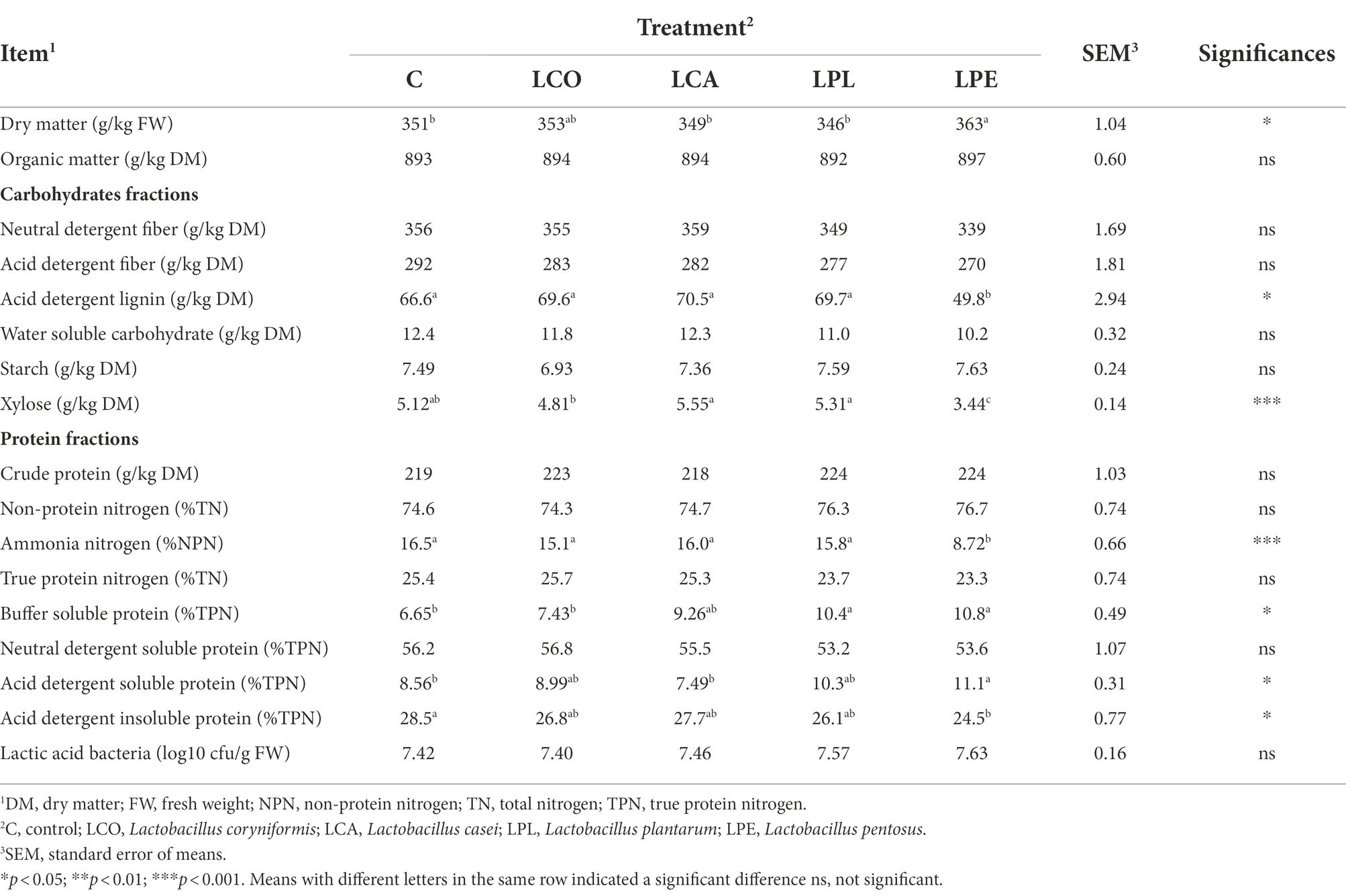
Table 3. Effect of lactobacillus on chemical composition and lactic acid bacteria populations of alfalfa silages after 60 days ensiling.
The contents of ammonia-N and butyric acid are the critical index to determine the fermentation quality of silage. These two variables should be less than threshold of 10% TN and 0.2% DM, respectively, in well-preserved silage (Catchpoole and Henzell, 1971). According to this criterion, all silages except LPE treatment did not obtain good fermentation quality. Although butyric acid was not detected, their ammonia-N content exceeded the threshold after 15 days ensiling. Butyric acid was absent in all silages after wilting, which was consistent with the report of Zhang et al. (2020). Accumulation of butyric acid is associated with clostridium activity during ensiling. Under neutral conditions, the optimum and the minimum water activity for clostridium growth were 0.995 and 0.971, respectively, and the minimum water activity increased with the pH declined. Moreover, clostridia are more susceptible to water activity than LAB, the latter are the most tolerant of low water activity, about 0.930 to 0.945 (Buxton et al., 2003). In this study, the water activity of wilted alfalfa was about 0.972. Clostridium growth may be completely suppressed after wilting, supported by the absence of butyric acid detection in all silages.
Effects of lactobacillus inoculation on carbohydrate and nitrogenous fractions of alfalfa silage
Lactobacilli inoculants had no significant effect on carbohydrate fractions, such as WSC, starch, NDF and ADF contents in alfalfa silage (Table 3). Oliveira et al. (2017) summarized 1747 literatures and pointed out that silage inoculated with homofermentative and facultative heterofermentative LAB could reduce WSC content and promote lactic acid production in silage, but did not affect NDF content. In this study, the residual WSC content did not show a significant difference (p > 0.05) among all silages. This might be due to insufficient WSC content of fresh forages, which were fully utilized by LAB during ensiling. However, LPE silage had the lowest xylose content (p < 0.001) among all silages, which was due to the fact that L. pentosus can ferment xylose to produce lactic acid. Most strains of LAB do not hydrolyze starch and cellulose (McDonald et al., 1991). Therefore, there were no differences (p > 0.05) in the starch, NDF and ADF contents among all silages. In addition, LPE silage had lower (p < 0.05) ADL content and higher (p < 0.05) DM content than that of C silage. The ADL is difficult to degrade during ensiling, and its content is negatively correlated with dry matter loss (Guo et al., 2014). Thus, this might be related to the good quality of LPE silage, since high quality silage usually has low dry matter loss (Buxton et al., 2003).
In contrast to carbohydrate fractions, ensiling did not affect the crude protein content of forage, but large amounts of TP are decomposed into NPN during ensiling. Proteolysis in silage can be inhibited by LAB inoculation (Tao et al., 2017; Guo et al., 2020). In the current study, silage inoculated with lactobacillus had no significant effect on the CP content and the proportion of NPN, but the proportion of ammonia-N in LPE silage decreased (p < 0.05) compared to C silage (Table 3). This is due to the rapid decrease in silage pH, which inhibits further decarboxylation or deamination of amino acids by harmful microorganisms (Buxton et al., 2003). Compared with C silage, lactobacilli inoculants tended to increase the proportion of buffer soluble protein and acid detergent soluble protein in TP. The research by Tao et al. (2017) showed similar changes in silage protein fractions after LAB inoculation.
Effects of lactobacillus inoculation on the bacterial community in alfalfa silage
The alpha-diversity index of alfalfa silage inoculated with or without lactobacillus are shown in Table 4. The Goods_coverage index of each group was over 0.99, indicating that the sequencing analysis could reflect the real bacterial community composition in silage samples. Alfalfa silage inoculated with L. pentosus had lower (p < 0.05) Shannon, Chao1 and ACE index than that of C treatment, indicating that the bacterial diversity was reduced. This was due to the fact that the decreased pH resulted from LAB inoculation inhibited the growth of acid-resistant bacteria and thus reduced the bacterial diversity in silage (Zhao et al., 2021).
The PCoA of bacterial community in alfalfa silage inoculated with or without lactobacillus is shown in Figure 1. Samples from each treatment were individually clustered within a narrow range, indicating good sample repeatability. The distribution and composition of microbial communities were significantly separated and varied across treatments. The C and LCA group samples were mainly clustered in the upper left quadrants. However, the other three groups were completely separated from C and LCA group, with the LPE, LPL and LCO group samples locating in the upper right, lower right, and lower left quadrants, respectively. This result indicated that the L. coryneformis, L. plantarum and L. pentosus inoculants could significantly affected microbial composition compared L. casei. Similarly, Yang et al. (2019) found that of the L. plantarum inoculants could markedly affect the bacterial community composition of alfalfa silage.
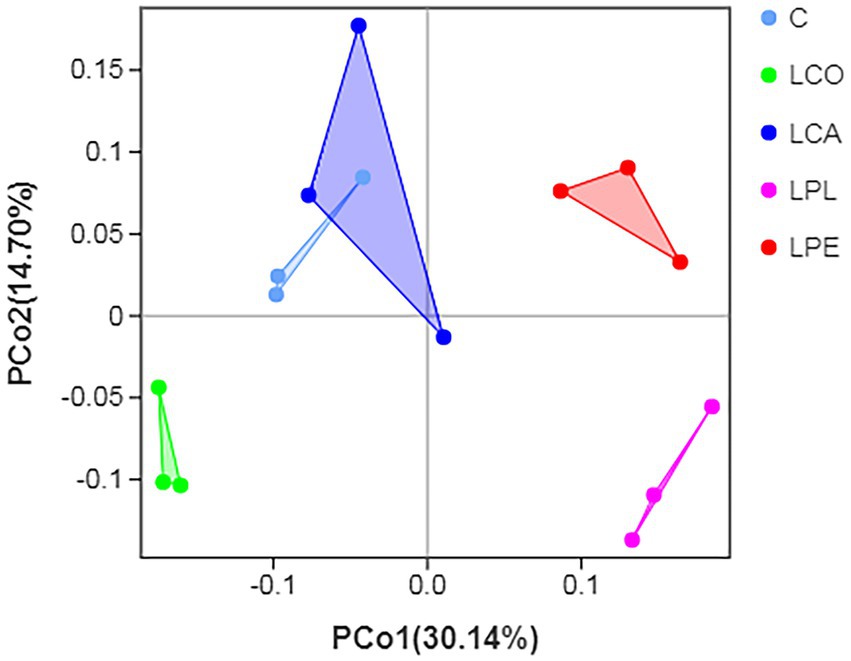
Figure 1. Differences in microbial community diversity on genus level shown by PCoA. C, control; LCO, Lactobacillus coryneformis; LCA, Lactobacillus casei; LPL, Lactobacillus plantarum; LPE, Lactobacillus pentosus.
The relative abundance of bacterial community in alfalfa silage at the phylum level is shown in Figure 2A. In general, the dominant phylum was Firmicutes, followed by Proteobacteria in all silages. McGarvey et al. (2013) reported that the relative abundance of Firmicutes in alfalfa silage usually more than 95%. In the current study, the relative abundance of Firmicutes in alfalfa silage after 60 days ensiling was more than 99%, except LCO group (about 95%). Proteobacteria are usually the dominant phylum in fresh forage before ensiling, and the bacterial community shifts from Proteobacteria to Firmicutes during ensiling (Keshri et al., 2018). Ni et al. (2018) reported that the major genera related to silage fermentation were Lactobacillus, Pediococcus, Weissella, and Leuconostoc, all of which belonged to Firmicutes. As exhibited in Figure 2B, the prevalent genera in alfalfa silage were Lactobacillus and Pediococcus in this study. The relative abundance of Lactobacillus in alfalfa silage were 83.5, 77.8, 76.0, 65.9 and 38.1% in LPE, LCA, LPL, C and LCO group, respectively. The relative abundance of Pediococcus in alfalfa silage was in the following order: LCO (45.0%) > C (32.0%) > LPL (22.2%) > LCA (21.1%) > LPE (15.4%). Generally, Pediococcus usually grow vigorously and initiate lactic acid fermentation in the early stage of silage, while they will be gradually replaced by Lactobacillus as the pH decreases (Ni et al., 2017). In present study, the highest relative abundance of Lactobacillus and lowest relative abundance of Pediococcus in LPE silage corresponded to the lowest silage pH. However, higher relative abundance of Pediococcus in the LCO group may be relative to the postponed formation of acidic environment (Yang et al., 2019). The relative abundance of Weissella and Leuconostoc were extremely minor in all silages, which were in consistent with the finding of Ogunade et al. (2018), who concluded that silage inoculated with LAB could decrease the relative abundance of Weissella. It is interesting to note that the Lysinibacillus and Comamonas were only found in the LCO silage. However, researchers reported that the Lysinibacillus and Comamonas could not assimilate and ferment sugars (Ni et al., 2013).
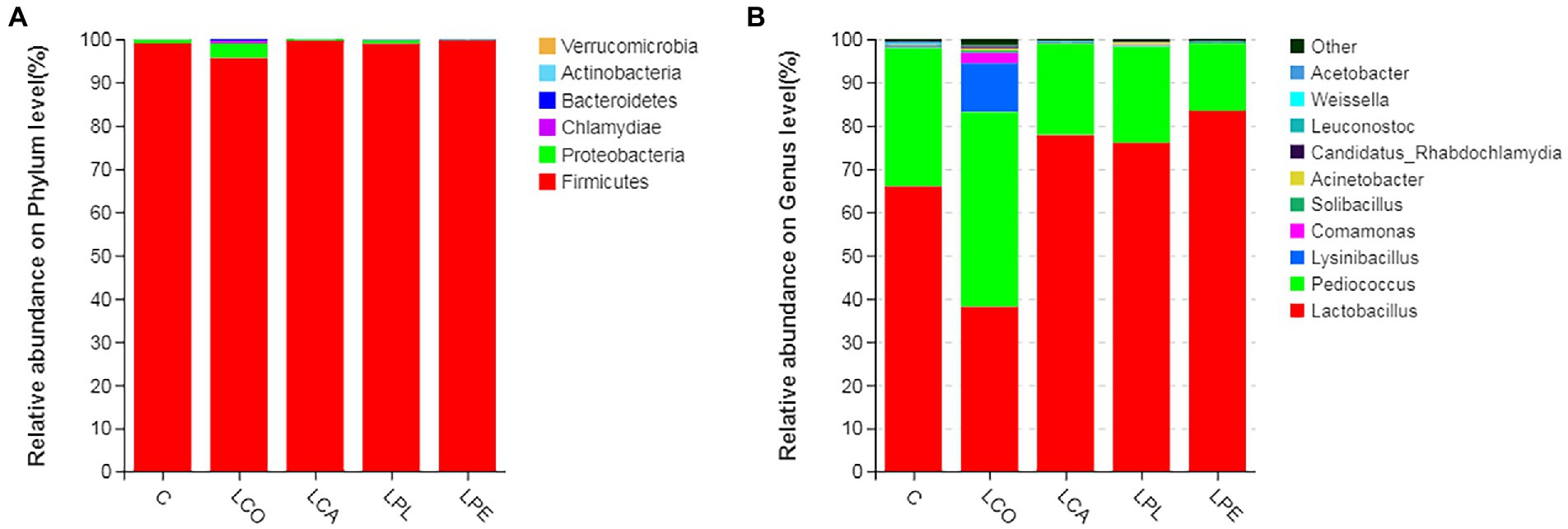
Figure 2. Relative abundance of bacterial community by phylum (A) and genus (B) for alfalfa silage. C, control; LCO, Lactobacillus coryneformis; LCA, Lactobacillus casei; LPL, Lactobacillus plantarum; LPE, Lactobacillus pentosus.
The functional prediction of microbial community in alfalfa silage inoculated with or without lactobacilli based on 16S rDNA gene are shown in Figure 3. Compared with the C silage, the metabolism of carbohydrate, glycan, nucleotide, terpenoids and polyketides, amino acid and energy, and biosynthesis of other secondary metabolites were up-regulated by LCA, LPL, or LPE treatments, especially LPE treatment, which significantly up-regulated amino acid, carbohydrate, energy, terpenoids and polyketides metabolism. Previous studies have reported that the decrease in ammonia-N content is accompanied by the down-regulation of amino acid metabolism of microbial community in good silage (Bai et al., 2022). The results of the LPE treatment did not fit this theory, with the highest level of amino acid metabolism and the lowest ammonia-N content among all treatments. However, the LPE treatment also had high buffer soluble protein contents and low acid detergent insoluble protein. This might be due to the fact that the large degradation of amino acids and small peptides caused by harmful microorganisms, such as clostridium and enterobacter, did not occur during proteolysis (Yuan et al., 2020). In addition, the up-regulated energy, terpenoids and polyketides metabolism in LPE silage, which was consistent with the report of Xu et al. (2019), who found that the energy metabolism was up-regulated when silage inoculated with LAB. In present study, it was interesting to note that carbohydrate, glycan and nucleotide metabolism was down-regulated and lipid, xenobiotics biodegradation, cofactors and vitamins metabolism was up-regulated in the LCO treatment compared with the C treatment. Limited studies have found that L. coryniformis has an inhibitory effect on clostridium and yeast by producing bacteriocins (Tanaka et al., 2009; Slavica et al., 2015). These bacteriocins might inhibit microbial growth by reducing its carbohydrate, glycan and nucleotide metabolism. Meanwhile, the L. coryniformis inoculants might enhance its biodegradation activities by mobilizing the metabolism of lipid and cofactors and vitamins to remove the xenobiotics.
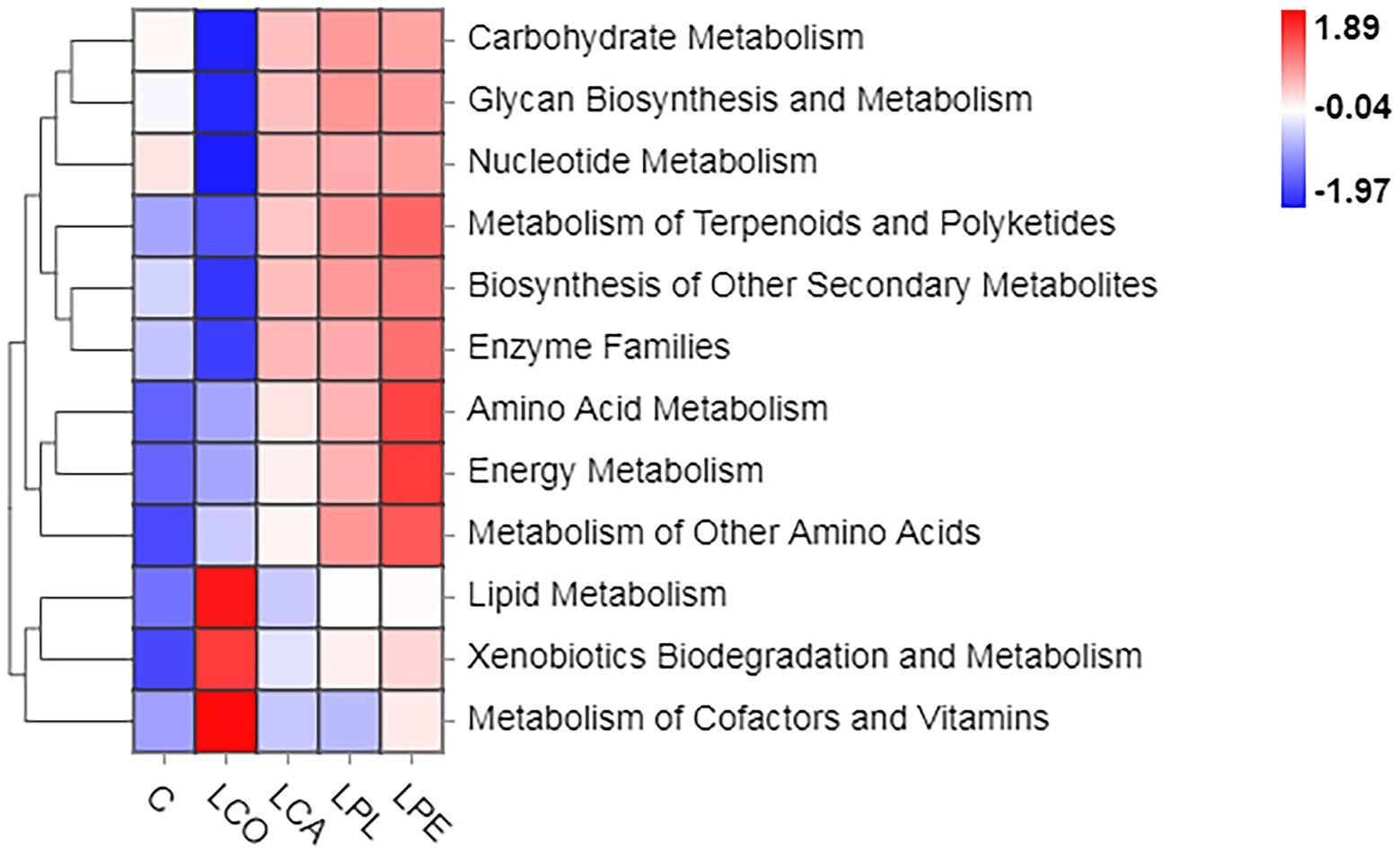
Figure 3. Metabolic functional analysis of microbial community using PICRUSt2. C, control; LCO, Lactobacillus coryneformis; LCA, Lactobacillus casei; LPL, Lactobacillus plantarum; LPE, Lactobacillus pentosus.
Conclusion
The L. pentosus inoculants enhanced lactic fermentation, which had the highest lactic acid content and lowest silage pH, acetic acid and ammonia-N contents, and thus improved fermentation quality of alfalfa silage. The residual WSC content was not different among all silages, L. pentosus inoculants was more efficient at using xylose to produce lactic acid, with lower xylose and acetic acid contents and higher lactic acid content in the silage than the other LAB inoculants. The L. coryniformis, L. casei and L. plantarum inoculants had limited effect on fermentation quality of alfalfa silage. Silage inoculated with lactobacillus tended to increase the proportion of buffer soluble protein and acid detergent soluble protein in TP. Compared with the control, L. pentosus inoculants reduced the bacterial diversity in alfalfa silage, with lower Shannon, Chao 1 and ACE indices, and promoted relative abundance of lactobacillus and decreased the relative abundance of Pediococcus. As well as L. pentosus inoculants up-regulated amino acid, carbohydrate, energy, terpenoids and polyketides metabolism, and promoted lactic acid fermentation process. In summary, L. pentosus used as an additive was superior to the other three lactobacillus species in improving fermentation quality of alfalfa silage.
Data availability statement
The datasets presented in this study can be found in online repositories. The names of the repository/repositories and accession number (s) can be found at: https://www.ncbi.nlm.nih.gov/, PRJNA888371.
Author contributions
WH wrote the manuscript. GG designed the study. WH, YZ, LZ, CS, and LC performed the experiments. QL, SZ, CW, and GG conducted the statistical data and bioinformatics analyses. All authors contributed to the article and approved the submitted version.
Funding
This work was supported by the grant for National Natural Science Foundation of China (nos. 32001405 and 31502015) and Animal Husbandry Key Discipline construction program in “1331 project” of Shanxi Province.
Conflict of interest
The authors declare that the research was conducted in the absence of any commercial or financial relationships that could be construed as a potential conflict of interest.
Publisher’s note
All claims expressed in this article are solely those of the authors and do not necessarily represent those of their affiliated organizations, or those of the publisher, the editors and the reviewers. Any product that may be evaluated in this article, or claim that may be made by its manufacturer, is not guaranteed or endorsed by the publisher.
References
AOAC (2012). Official Methods of Analysis. 19th Gaithersburg, MD: Association of Official Analytical Chemists.
Bai, J., Franco, M., Ding, Z., Hao, L., Ke, W., Wang, M., et al. (2022). Effect of Bacillus amyloliquefaciens and Bacillus subtilis on fermentation, dynamics of bacterial community and their functional shifts of whole-plant corn silage. J. Anim. Sci. Biotechnol. 13, 1–14. doi: 10.1186/s40104-021-00649-0
Buxton, D. R., Muck, R. E., and Harrison, J. H. (2003). Silage science and technology. Madison,WI: ASA, CSSA and SSSA Publishers.
Cai, Y. M., Benno, Y., Ogawa, M., and Kumai, S. (1999). Effect of applying lactic acid bacteria isolated from forage crops on fermentation characteristics and aerobic deterioration of silage. J. Dairy Sci. 82, 520–526. doi: 10.3168/jds.S0022-0302(99)75263-X
Canale, C. J., Varga, G. A., and Abrams, S. M. (1991). In situ disappearance of cell wall monosaccharides in alkali-treated orchardgrass and alfalfa. J. Dairy Sci. 74, 1018–1025.
Catchpoole, V. R., and Henzell, E. F. (1971). Silage and silage making from tropical herbage species. Herb Abstr 41, 213–221.
Contreras-Govea, F. E., Muck, R. E., Mertens, D. R., and Weimer, P. J. (2011). Microbial inoculant effects on silage and in vitro ruminal fermentation, and microbial biomass estimation for alfalfa, bmr corn, and corn silages. Anim. Feed Sci. Technol. 163, 2–10. doi: 10.1016/j.anifeedsci.2010.09.015
Desta, S. T., Yuan, X. J., Li, J. F., and Shao, T. (2016). Ensiling characteristics, structural and nonstructural carbohydrate composition and enzymatic digestibility of Napier grass ensiled with additives. Bioresour. Technol. 221, 447–454. doi: 10.1016/j.biortech.2016.09.068
Eberts, T. J., Sample, R. H., Glick, M. R., and Ellis, G. H. (1979). A simplified, colorimetric micro method for xylose in serum or urine, with phloroglucinol. Clin. Chem. 25, 1440–1443. doi: 10.1093/clinchem/25.8.1440
Ertekin, I., and Kizilsimsek, M. (2020). Effects of lactic acid bacteria inoculation in pre-harvesting period on fermentation and feed quality properties of alfalfa silage. Asian-Aust. J. Anim. Sci. 33, 245–253. doi: 10.5713/ajas.18.0801
Guo, X. S., Bai, J., Li, F. H., Xu, D. M., Zhang, Y. X., Bu, D. P., et al. (2020). Effects of malate, citrate, succinate and fumarate on fermentation, chemical composition, aerobic stability and digestibility of alfalfa silage. Anim. Feed Sci. Technol. 268:114604. doi: 10.1016/j.anifeedsci.2020.114604
Guo, G., Shen, C., Liu, Q., Zhang, S. L., Wang, C., Chen, L., et al. (2019). Fermentation quality and in vitro digestibility of first and second cut alfalfa (Medicago sativa L.) silages harvested at three stages of maturity. Anim. Feed Sci. Technol. 257:114274. doi: 10.1016/j.anifeedsci.2019.114274
Guo, G., Yuan, X. J., Li, L. X., Wen, A. Y., and Shao, T. (2014). Effects of fibrolytic enzymes, molasses and lactic acid bacteria on fermentation quality of mixed silage of corn and hulless–barely straw in the Tibetan plateau. Grassl. Sci. 60, 240–246. doi: 10.1111/grs.12060
Keshri, J., Chen, Y., Pinto, R., Kroupitski, Y., Weinberg, Z. G., and Sela Saldinger, S. (2018). Microbiome dynamics during ensiling of corn with and without Lactobacillus plantarum inoculant. Appl. Microbiol. Biotechnol. 102, 4025–4037. doi: 10.1007/s00253-018-8903-y
Kim, S. C., and Adesogan, A. T. (2006). Influence of ensiling temperature, simulated rainfall, and delayed sealing on fermentation characteristics and aerobic stability of corn silage. J. Dairy Sci. 89, 3122–3132. doi: 10.3168/jds.S0022-0302(06)72586-3
Kleinschmit, D. H., Schmidt, R. J., and Kung, L. Jr. (2005). The effects of various antifungal additives on the fermentation and aerobic stability of corn silage. J. Dairy Sci. 88, 2130–2139. doi: 10.3168/jds.S0022-0302(05)72889-7
Kung, L., Shaver, R. D., Grant, R. J., and Schmidt, R. J. (2018). Silage review: interpretation of chemical, microbial, and organoleptic components of silages. J. Dairy Sci. 101, 4020–4033. doi: 10.3168/jds.2017-13909
Li, D. X., Ni, K. K., Zhang, Y. C., Lin, Y. L., and Yang, F. Y. (2018). Influence of lactic acid bacteria, cellulase, cellulase-producing Bacillus pumilus and their combinations on alfalfa silage quality. J. Integr. Agr. 17, 2768–2782. doi: 10.1016/S2095-3119(18)62060-X
Licitra, G., Hernandez, T. M., and VanSoest, P. J. (1996). Standardization of procedures for nitrogen fractionation of ruminant feeds. Anim. Feed Sci. Technol. 57, 347–358. doi: 10.1016/0377-8401(95)00837-3
Liu, Q. H., Chen, M. X., Zhang, J. G., Shi, S. L., and Cai, Y. M. (2012). Characteristics of isolated lactic acid bacteria and their effectiveness to improve stylo (Stylosanthes guianensis Sw.) silage quality at various temperatures. Anim. Sci. J. 83, 128–135. doi: 10.1111/j.1740-0929.2011.00937.x
McDonald, P., Henderson, A. R., and Heron, S. J. (1991). The biochemistry of silage. 2nd Aberystwyth, UK: Cambrian Printers Ltd.
McGarvey, J. A., Franco, R. B., Palumbo, J. D., Hnasko, R., Stanker, L., and Mitloehner, F. M. (2013). Bacterial population dynamics during the ensiling of Medicago sativa (alfalfa) and subsequent exposure to air. J. Appl. Microbiol. 114, 1661–1670. doi: 10.1111/jam.12179
Nadeau, E., Rochardt, W., Murphy, M., and Auerbach, H. (2012). Protein quality dynamics during wilting and preservation of grass-legume forage. Proceedings of the XVI International Silage Conference, eds. K. Kuoppala, M. Rinne, and A. Vanhatalo Hämeenlinna, Finland, 56–57.
Namihira, T., Shinzato, N., Akamine, H., Maekawa, H., and Matsui, T. (2010). Influence of nitrogen fertilization on tropical-grass silage assessed by ensiling process monitoring using chemical and microbial community analyses. J. Appl. Microbiol. 108, 1954–1965. doi: 10.1111/j.1365-2672.2009.04591.x
Ni, K. K., Wang, Y. P., Li, D. X., Cai, Y. M., and Pang, H. L. (2015). Characterization, identification and application of lactic acid bacteria isolated from forage Paddy Rice silage. PLoS One 10, 1–14. doi: 10.1371/journal.pone.0121967
Ni, K., Wang, F., Zhu, B., Yang, J., Zhou, G., Pan, Y., et al. (2017). Effects oflactic acid bacteria and molasses additives on the microbial community and fermentation quality of soybean silage. Bioresour. Technol. 238, 706–715. doi: 10.1016/j.biortech.2017.04.055
Ni, K., Zhao, J., Zhu, B., Su, R., Pan, Y., Ma, J., et al. (2018). Assessing the fermentation quality and microbial community of the mixed silage offorage soybean with crop corn or sorghum. Bioresour. Technol. 265, 563–567. doi: 10.1016/j.biortech.2018.05.097
Ni, B., Zhang, Y., Chen, D. W., Wang, B. J., and Liu, S. J. (2013). Assimilation of aromatic compounds by Comamonas testosteroni: characterization and spreadability of protocatechuate 4,5-cleavage pathway in bacteria. Appl. Microbiol. Biotechnol. 97, 6031–6041. doi: 10.1007/s00253-012-4402-8
Ogunade, I. M., Jiang, Y., Cervantes, A. A. P., Kim, D. H., Oliveira, A. S., Vyas, D., Weinberg, Z. G., Jeong, K. C., and Adesogan, A. T. (2018). Bacterial diversity and composition of alfalfasilage as analyzed by Illumina MiSeq sequencing: effects of Escherichia coli O157:H7and silage additives. J. Dairy Sci. 101, 2048–2059, doi: 10.3168/jds.2017-12876
Oliveira, A. S., Weinberg, Z. G., Ogunade, I. M., Cervantes, A. A. P., Arriola, K. G., Jiang, Y., et al. (2017). Meta-analysis of effects of inoculation with homofermentative and facultative heterofermentative lactic acid bacteria on silage fermentation, aerobic stability, and the performance of dairy cows. J. Dairy Sci. 100, 4587–4603. doi: 10.3168/jds.2016-11815
Owens, V. N., Albrecht, K. A., and Muck, R. E. (2002). Protein degradation and fermentation characteristics of unwilted red clover and alfalfa silage harvested at various times during the day. Grass Forage Sci. 57, 329–341. doi: 10.1046/j.1365-2494.2002.00333.x
Pitt, R. E. (1990). “Silage and hay preservation,” in NRAES-5. Northeast Regional Agricultural Engineering Service (Ithaca, NY: Natural Resource, Agriculture, and Engineering Service).
Playne, M. J., and McDonald, P. (1966). The buffering constituents of herbage and silage. J. Sci. Food Agric. 17, 264–268. doi: 10.1002/jsfa.2740170609
Shao, T., Wanga, T., Shimojo, M., and Masuda, Y. (2005). Effect of ensiling density on fermentation quality of guinea grass (Panicum maximum Jacq.) silage during the early stage of ensiling. Asian-Aust. J. Anim. Sci. 18, 1273–1278. doi: 10.5713/ajas.2005.1273
Slavica, A., Trontel, A., Jelovac, N., Kosovec, E., Antek, B., and Novak, S. (2015). Production of lactate and acetate by Lactobacillus coryniformis subsp. torquens DSM 20004T in comparison with Lactobacillus amylovorus DSM 20531T. J. Biotechnol. 202, 50–59. doi: 10.1016/j.jbiotec.2015.01.014
Tanaka, O., Komatsu, T., Oshibe, A., Cai, Y. M., Miyazaki, S., and Nakanishi, K. (2009). Production of 3-hydroxypropionaldehyde in silage inoculated with Lactobacillus coryniformis plus glycerol. Biosci. Biotechnol. Biochem. 73, 1494–1499. doi: 10.1271/bbb.80863
Tao, L., Zhou, H., Zhang, N. F., Si, B. W., Tu, Y., Ma, T., et al. (2017). Effects of different source additives and wilt conditions on the pH value, aerobic stability, and carbohydrate and protein fractions of alfalfa silage. Anim. Sci. J. 88, 99–106. doi: 10.1111/asj.12599
Tian, J., Li, Z., Yu, Z., Zhang, Q., and Li, X. J. (2017). Interactive effect of inoculant and dried jujube powder on the fermentation quality and nitrogen fraction of alfalfa silage. Anim. Sci. J. 88, 633–642. doi: 10.1111/asj.12689
Tohno, M., Kobayashi, H., Nomura, M., Kitahara, M., Ohkuma, M., Uegaki, R., et al. (2012). Genotypic and phenotypic characterization of lactic acid bacteria isolated from Italian ryegrass silage. Anim. Sci. J. 83, 111–120. doi: 10.1111/j.1740-0929.2011.00923.x
VanSoest, P. J., Robertson, J. B., and Lewis, B. A. (1991). Methods for dietary fiber, neutral detergent fiber and non-starch polysaccharides in relation to animal nutrition. J. Dairy Sci. 74, 3583–3597. doi: 10.3168/jds.S0022-0302(91)78551-2
Wang, B., Gao, R., Wu, Z., and Yu, Z. (2020). Functional analysis of sugars in modulating bacterial communities and metabolomics profiles of Medicago sativa silage. Front. Microbiol. 11:641. doi: 10.3389/fmicb.2020.00641
Wang, J., Wang, J. Q., Zhou, H., and Feng, T. (2009). Effects of addition of previously fermented juice prepared from alfalfa on fermentation quality and protein degradation of alfalfa silage. Anim. Feed Sci. Technol. 151, 280–290. doi: 10.1016/j.anifeedsci.2009.03.001
Xu, D. M., Ding, W., Ke, W., Li, F., Zhang, P., and Guo, X. S. (2019). Modulation of metabolome and bacterial community in whole crop corn silage by inoculating homofermentative Lactobacillus plantarum and heterofermentative Lactobacillus buchneri. Front. Microbiol. 9:3299. doi: 10.3389/fmicb.2018.03299
Yang, L. L., Yuan, X. J., Li, J. F., Dong, Z. H., and Shao, T. (2019). Dynamics of microbial community and fermentation quality during ensiling of sterile and non-sterile alfalfa with or without Lactobacillus plantarum inoculants. Bioresour. Technol. 275, 280–287. doi: 10.1016/j.biortech.2018.12.067
Yuan, X. J., Li, J. F., Dong, Z. H., and Shao, T. (2020). The reconstitution mechanism of napier grass microiota during the ensiling of alfalfa and their contributions to fermentation quality of silage. Bioresour. Technol. 297:122391. doi: 10.1016/j.biortech.2019.122391
Zhang, Y. X., Ke, W. C., Bai, J., Li, F. H., Xu, D. M., Ding, Z. T., et al. (2020). The effect of Pediococcus acidilactici J17 with high-antioxidant activity on antioxidant, α-tocopherol, β-carotene, fatty acids, and fermentation profiles of alfalfa silage ensiled at two different dry matter contents. Anim. Feed Sci. Technol. 268:114614. doi: 10.1016/j.anifeedsci.2020.114614
Keywords: alfalfa silage, lactobacilli inoculants, ensiling characteristics, protein fractions, bacterial community
Citation: Huo W, Zhang Y, Zhang L, Shen C, Chen L, Liu Q, Zhang S, Wang C and Guo G (2022) Effect of lactobacilli inoculation on protein and carbohydrate fractions, ensiling characteristics and bacterial community of alfalfa silage. Front. Microbiol. 13:1070175. doi: 10.3389/fmicb.2022.1070175
Edited by:
Siran Wang, Nanjing Agricultural University, ChinaReviewed by:
Ping Li, Guizhou University, ChinaLin Sun, Inner Mongolia Academy of Agricultural and Animal Husbandry Sciences, China
Copyright © 2022 Huo, Zhang, Zhang, Shen, Chen, Liu, Zhang, Wang and Guo. This is an open-access article distributed under the terms of the Creative Commons Attribution License (CC BY). The use, distribution or reproduction in other forums is permitted, provided the original author(s) and the copyright owner(s) are credited and that the original publication in this journal is cited, in accordance with accepted academic practice. No use, distribution or reproduction is permitted which does not comply with these terms.
*Correspondence: Gang Guo, Z2dnZzE5ODRAMTYzLmNvbQ==
 Wenjie Huo
Wenjie Huo Yujuan Zhang
Yujuan Zhang Luyao Zhang
Luyao Zhang Qiang Liu
Qiang Liu Gang Guo
Gang Guo